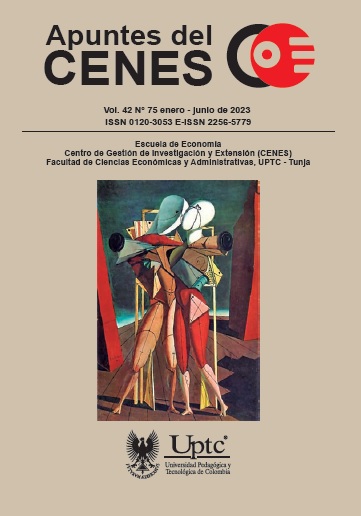Distribution and Growth in Open Economies: A Post-kaleckian Explanation

Abstract
In this paper the framework proposed by Velázquez (2022) is expanded to analyze the bidirectional relationship between the economic growth and the functional income distribution in open economies. Two exchange regimes are analyzed: the fixed and floating exchange rates. It is shown that if growth is led by wage, growth and distribution paths are cyclic, regardless the exchange rate policies. On the other hand, if growth is led by profits and the exchange rate is flexible, then growth is steady and the profit sharing goes upwards. However, if in this scenario there is a fix exchange rate, the growth and distribution paths are cyclic.
Keywords
Post-Kaleckian, growth, distribution, wage-led growth, profit-led growth
References
- Alvater, E. (2015). La obsesión del crecimiento. Argumentos, 28(77), 209-288. http://www.scielo.org.mx/pdf/argu/v28n77/v28n77a10.pdf
- Assous, M., & Dutt, A. K. (2013). Growth and Income Distribution with the Dynamics of Power in Labour and goods Markets. Cambridge Journal of Economics, 37(6), 1407-1430. https://doi.org/10.1093/cje/bes086 DOI: https://doi.org/10.1093/cje/bes086
- Bhaduri, A. (2008). On the Dynamics of Profit-led and Wage-led Growth. Cambridge Journal of Economics, 32(1), 147-160. https://doi.org/10.1093/cje/bem012 DOI: https://doi.org/10.1093/cje/bem012
- Bhaduri, A., & Marglin, S. (1990). Unemployment and the Real Wage: the Economic Basis for Contesting Political Ideologies. Cambridge Journal of Economics, 14(4), 375-393. https://doi.org/10.1093/oxfordjournals.cje.a035141 DOI: https://doi.org/10.1093/oxfordjournals.cje.a035141
- Cassetti, M. (2003). Bargaininig Power, effective Demand and Technical Progress: A Kaleckian Model of Growth. Cambridge Journal of Economics, 27(3), 449-469. https://doi.org/10.1093/cje/27.3.449 DOI: https://doi.org/10.1093/cje/27.3.449
- Dutt, A. K. (2012). Distributional Dynamics in Post-Keynesian Models. Journal of Post Keynesian Economics, 34(3), 431-452.https://doi.org/10.2753/PKE0160-3477340303 DOI: https://doi.org/10.2753/PKE0160-3477340303
- Hamilton, C. (2006). El fetiche del crecimiento. Laetoli.
- Hein, E. (2007). Interest Rate, Debt, Distribution and Capital Accumulation in a Post-Kaleckian Model. Metroeconomica, 58(2), 146-177. https://doi.org/10.1111/j.1467-999X.2007.00270.x DOI: https://doi.org/10.1111/j.1467-999X.2007.00270.x
- Hein, E. (2014). Distribution and Growth After Keynes. Edward Elgar Publishing. https://doi.org/10.4337/9781783477296 DOI: https://doi.org/10.4337/9781783477296
- Hein, E. (2017). Post-Keynesian Macroeconomics Since the Mid 1990s: Main Developments. European Journal of Economics and Economic Policies: Intervention, 14(2), 131-172. https://doi.org/10.4337/ejeep.2017.02.01 DOI: https://doi.org/10.4337/ejeep.2017.02.01
- ILO. (2011). Making Markets Work for Jobs. ILO. https://www.ilo.org/wcmsp5/groups/public/@dgreports/@dcomm/@publ/documents/publication/wcms_166021.pdf
- ILO & OCDE. (2015). The Labour Share in G20 Economies. In Report Prepared for the G20 Employment Working Group Antalya. ILO & OCDE. https://www.oecd.org/g20/topics/employment-and-social-poli-cy/The-Labour-Share-in-G20-Economies.pdf.
- IMF. (2007). The Globalization of Labor. In W. E. Economy. IMF. file:///C:/Users/84861%20HP_ODM002/AppData/Local/Packages/Microsoft.MicrosoftEdge_8wekyb3d8bbwe/TempState/Downloads/_textpdf%20(1).pdf
- Kalecki, M. (1943). Studies in Economic Dynamics. George Allen and Unwin.
- Kalecki, M. (1977). Ensayos escogidos sobre dinámica de la economía capitalista. Fondo de Cultura Económica.
- Keynes, J. M. (2004). Teoría general de la ocupación, el interés y el dinero. Fondo de Cultura Económica.
- Lavoie, M. & Stockhammer, E. (2023). Crecimiento impulsado por los salarios: concepto, teorías y políticas. El trimestre económico, 90(1)(357), 215-265. https://doi.org/10.20430/ete.v90i357.1781 DOI: https://doi.org/10.20430/ete.v90i357.1781
- Naastepad, C. W., & Storm, S. (2006). OECD Demand regimes (1960-2000). Journal of Post Keynesian Economics, 29(2), 213-248. https://doi.org/10.2753/PKE0160-3477290203 DOI: https://doi.org/10.2753/PKE0160-3477290203
- Onaran, Ö., & Galanis, G. (2012). Is Aggregate Demand Wage or Profit-led? National and Global Effects. ILO. https://www.ilo.org/wcmsp5/groups/public/---ed_protect/---protrav/---travail/documents/publication/wcms_192121.pdf
- Pentecost, E. (1993). Exchange Rate Dynamics. Edward Elgar.
- Piketty, T. (2014). El capital en el siglo XXI. Fondo de Cultura Económica.
- Piketty, T. (2019). Capital e ideología. Grano de Sal.
- Robinson, J. (1980). Time in Economic Theory. Kyklos: International Review of Social Sciences, 33, 219-229. https://doi.org/10.1111/j.1467-6435.1980.tb02632.x DOI: https://doi.org/10.1111/j.1467-6435.1980.tb02632.x
- Skott, P. (2017). Weaknesses of Wage-led Growth. Review of Keynesian Economics, 5(3), 131-172. https://doi.org/10.4337/roke.2017.03.03 DOI: https://doi.org/10.4337/roke.2017.03.03
- Stockhammer, E. (2013). Why Have Wage Shares Fallen? A Panel Analysis of Determinants of Functional Income Distribution. OIL Condition of Work and Employment Series, (35). https://www.ilo.org/public/libdoc/ilo/2013/470913.pdf DOI: https://doi.org/10.1057/9781137357939_3
- Stockhammer, E. (2017). Wage-Led Versus Profit-Led Demand: What Have We Learned? A Kaleckian Minskyan View. Review of Keysesian Economics, 5(1), 25-42. https://doi.org/10.4337/roke.2017.01.03 DOI: https://doi.org/10.4337/roke.2017.01.03
- Thirlwall, A. P. (1979). The Balance of Payments Constraint as an Explanation of International Growth Rate Differences. Banca Nazionale de Lavoro Quarterly Review, 32(128), 45-53.
- Vázquez, D. A., Aymar, I. M., & Lawson, M. (2018). Reward Work, Not Wealth. Oxfam. https://doi.org/10.21201/2017.1350
- Velázquez, D. Rodríguez, E. & González, J. M. (2017). Conflicto distributivo entre salarios y ganancias: revisión teórica. UAEH.
- Velázquez, D. (2021). Reduction of the Wage Share of Income. Cepal Review, 34, 173-194. https://doi.org/10.18356/16840348-2021-134-9
- Velázquez, D. (2022). Una explicación neokaleckiana de la relación bidireccional entre crecimiento y distribución. Problemas del Desarrollo. Revista Latinoamericana de Economía. 53(211), 107-132. https://doi.org/10.22201/iiec.20078951e.2022.211.69875 DOI: https://doi.org/10.22201/iiec.20078951e.2022.211.69875
